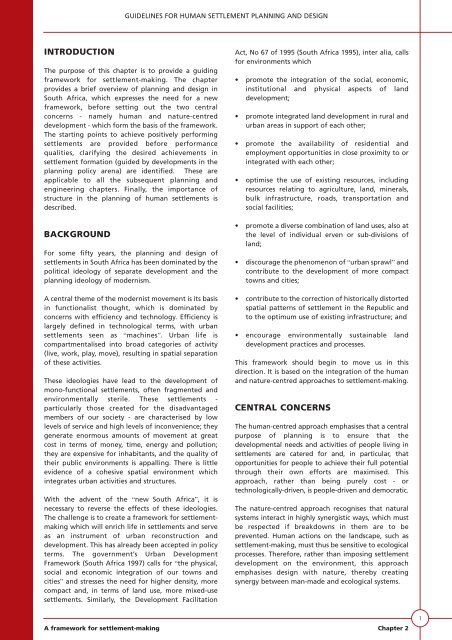VOLUME 1 HUMAN SETTLEMENT PLANNING AND ... - CSIR
VOLUME 1 HUMAN SETTLEMENT PLANNING AND ... - CSIR
VOLUME 1 HUMAN SETTLEMENT PLANNING AND ... - CSIR
- No tags were found...
You also want an ePaper? Increase the reach of your titles
YUMPU automatically turns print PDFs into web optimized ePapers that Google loves.
GUIDELINES FOR <strong>HUMAN</strong> <strong>SETTLEMENT</strong> <strong>PLANNING</strong> <strong>AND</strong> DESIGNINTRODUCTIONThe purpose of this chapter is to provide a guidingframework for settlement-making. The chapterprovides a brief overview of planning and design inSouth Africa, which expresses the need for a newframework, before setting out the two centralconcerns - namely human and nature-centreddevelopment - which form the basis of the framework.The starting points to achieve positively performingsettlements are provided before performancequalities, clarifying the desired achievements insettlement formation (guided by developments in theplanning policy arena) are identified. These areapplicable to all the subsequent planning andengineering chapters. Finally, the importance ofstructure in the planning of human settlements isdescribed.BACKGROUNDFor some fifty years, the planning and design ofsettlements in South Africa has been dominated by thepolitical ideology of separate development and theplanning ideology of modernism.A central theme of the modernist movement is its basisin functionalist thought, which is dominated byconcerns with efficiency and technology. Efficiency islargely defined in technological terms, with urbansettlements seen as “machines”. Urban life iscompartmentalised into broad categories of activity(live, work, play, move), resulting in spatial separationof these activities.These ideologies have lead to the development ofmono-functional settlements, often fragmented andenvironmentally sterile. These settlements -particularly those created for the disadvantagedmembers of our society - are characterised by lowlevels of service and high levels of inconvenience; theygenerate enormous amounts of movement at greatcost in terms of money, time, energy and pollution;they are expensive for inhabitants, and the quality oftheir public environments is appalling. There is littleevidence of a cohesive spatial environment whichintegrates urban activities and structures.With the advent of the “new South Africa”, it isnecessary to reverse the effects of these ideologies.The challenge is to create a framework for settlementmakingwhich will enrich life in settlements and serveas an instrument of urban reconstruction anddevelopment. This has already been accepted in policyterms. The government’s Urban DevelopmentFramework (South Africa 1997) calls for “the physical,social and economic integration of our towns andcities” and stresses the need for higher density, morecompact and, in terms of land use, more mixed-usesettlements. Similarly, the Development FacilitationAct, No 67 of 1995 (South Africa 1995), inter alia, callsfor environments which• promote the integration of the social, economic,institutional and physical aspects of landdevelopment;• promote integrated land development in rural andurban areas in support of each other;• promote the availability of residential andemployment opportunities in close proximity to orintegrated with each other;• optimise the use of existing resources, includingresources relating to agriculture, land, minerals,bulk infrastructure, roads, transportation andsocial facilities;• promote a diverse combination of land uses, also atthe level of individual erven or sub-divisions ofland;• discourage the phenomenon of “urban sprawl” andcontribute to the development of more compacttowns and cities;• contribute to the correction of historically distortedspatial patterns of settlement in the Republic andto the optimum use of existing infrastructure; and• encourage environmentally sustainable landdevelopment practices and processes.This framework should begin to move us in thisdirection. It is based on the integration of the humanand nature-centred approaches to settlement-making.CENTRAL CONCERNSThe human-centred approach emphasises that a centralpurpose of planning is to ensure that thedevelopmental needs and activities of people living insettlements are catered for and, in particular, thatopportunities for people to achieve their full potentialthrough their own efforts are maximised. Thisapproach, rather than being purely cost - ortechnologically-driven, is people-driven and democratic.The nature-centred approach recognises that naturalsystems interact in highly synergistic ways, which mustbe respected if breakdowns in them are to beprevented. Human actions on the landscape, such assettlement-making, must thus be sensitive to ecologicalprocesses. Therefore, rather than imposing settlementdevelopment on the environment, this approachemphasises design with nature, thereby creatingsynergy between man-made and ecological systems.A framework for settlement-making Chapter 21
















